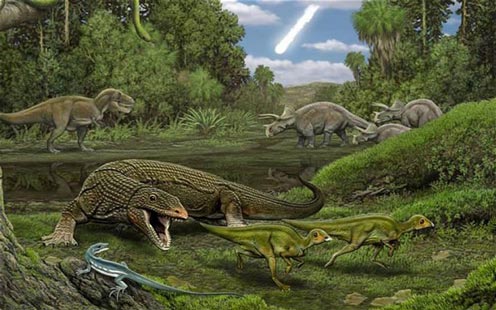Asteroid Strike Squashed the Squamata!
Most people now accept that there was a huge extra-terrestrial impact around sixty-six million years ago that contributed to the extinction of the dinosaurs. However, it was not just the Dinosauria that died out, many other types of animal and plant were also wiped out at around this time in our planet’s history. A new study by a team of American scientists has revealed that some groups of reptile, lizards and snakes for example, suffered extensive extinction amongst species and genera. More than eighty percent of all the Squamata (lizards and snakes), became extinct according to the researchers. Catastrophic climate change, rising sea levels and volcanic activity on a huge scale may have wiped out the likes of Triceratops and T. rex but all sorts of fauna and flora suffered including other types of reptile such as snakes and lizards.
The research team, lead by Nicholas Longrich a postdoctoral palaeontologist with the department of Geology and Geophysics at Yale University, reviewed the Squamata fossil assemblage from western North America (Maastrichtian faunal stage). They examined the diversity of lizard and snake fauna immediately before the Cretaceous mass extinction event that marked the end of the dinosaurs and the ending of the Mesozoic.
Cretaceous Mass Extinction
The team studied lizard and snake fossils from New Mexico in the south right up to Alberta (Canada) and they discovered a total of nine new species as a result of their research. During the course of the team’s research; fossils ascribed to the genera Leptochamops (L. denticulatus) were re-assigned to a new genera and a new species was established. This new species of insect-eating lizard, required a new scientific name and in honour of the President of the United States the lizard has been named Obamadon gracilis.
Cretaceous Lizard and Snake Fauna of Western North America
Picture credit: Carl Buell
The picture above shows the carnivorous lizard Palaeosaniwa stalking a pair of hatchling hadrosaurs (Edmontosaurus) as the snake Cerberophis basks on a tree branch and the agile lizard Obamadon looks on. In the background a Tyrannosaurus rex confronts a herd of ceratopsians (Triceratops), whilst the sky is lit up by a falling asteroid spelling doom for much of life on Earth.
“Obama’s Slender Teeth”
O. gracilis means “Obama’s slender teeth”, this little lizard, had tall, straight teeth and so the research team thought it a good idea to honour the President of the United States Barack Obama, as he to has a big, toothy smile. It is just one of nine new species that have been erected as a result of this research.
The study, the findings of which have been published in the academic journal “The Proceedings of the National Academy of Sciences”, suggests that as much as eighty-three percent of all Squamata species became extinct at the end of the Cretaceous geological period. This time may be known as the “Age of Dinosaurs”, but according to the researchers, a more appropriate term to describe the fauna might be the “Age of Lizards and Snakes”. The study shows that there were a large number of genera living in the shadow of the dinosaurs towards the end of the Cretaceous in western North America.
Snakes such as constrictors, large two-metre long predatory lizards that probably ate baby dinosaurs as well as a myriad of small, lithe lizards that scuttled in the undergrowth shared the Late Cretaceous world with the dinosaurs. Many of these animals, assigned to archaic Squamata genera became extinct, leaving the way for other types of lizard and snake to evolve in the Cenozoic.
Cretaceous Extinction
It seems that one fundamental Cretaceous extinction rule of thumb still applies, the larger the organism, the more likely it was to become extinct. Those lizards and snakes that did survive seem to have been very small, the bigger the snake or lizard the more likely it was to die out. One interesting and thought provoking outcome of this Squamata extinction is that if this pattern occurred across the planet, then the small mammals that survived into the Cenozoic would have found that there were very few reptile predators around to predate on them. Could the extinction of much of the Squamata have been a lucky break for the Mammalia?
For replicas and models of Late Cretaceous prehistoric reptiles including dinosaurs: Dinosaur Figures and Prehistoric Animal Replicas.
With the warming of the Earth during the early Palaeogene which gave rise to the establishment of extensive rain forests across much of the globe, lizard and snake populations gradually recovered and rapid speciation did occur, leading to the species that are found today. However, one previously common sub-family of lizards the Polyglyphanodontia were particularly hard it by the Cretaceous extinction event. The Yale based researchers have concluded that this clade of lizards were totally wiped out, leaving no descendants into the Cenozoic.
It seems that the dinosaurs were not the only losers at the end of the Mesozoic. At least the President of the United States can reflect on the honour of having a toothy lizard named after him.






Leave A Comment